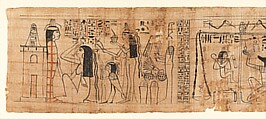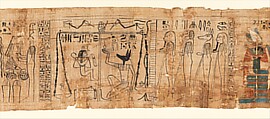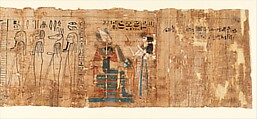Book of the Dead Papyrus of Tiye
Third Intermediate Period
Discovered tucked inside her hollow wooden "Osiris figure" (now Cairo JE 49164) this papyrus was designed to assist Tiye in her successful transition from death to eternal life. To the left, Tiye’s mummy is upright before her tomb, which is surmounted by a pyramidion bearing her name and titles. She mourned by one woman, who sits on the ground and raises her hand to her face, while a second woman offers incense and libations. Tiye’s ba (spirit) in the form of a human-headed bird raises her arms to partake of the water that flows from above. Above is an prayer asking for offerings from the king and Osirs. At the right of this scene, Osiris, identifed as the god of the west, the land of the dead, by the standard that replaces his head, stands before a pile of offerings. Such scenes are seen in association with Spell 1 of the Book of Coming Forth by Day (known to us as the Book of the Dead).
In the center is Spell 125 from the Book of Coming Forth by Day, the "Weighing of the Heart," in which Tiye proves that she is worthy of entering into the company of Osiris. The scale is operated by Anubis, jackal-headed god of embalming, who weighs Tiye’s heart against the hieroglyph for truth and correctness (ma’at). Just beyond the door leading to the Hall of Justice are four figures who are probably to be identified as the four sons of Horus, who protect the viscera of the deceased.
In the scene to the right, Tiye presents incense to Osiris, who speaks, asking that offerings be given to "the Lady of the House, Chantress of Amun, king of the gods, Tiye." This type of scene often introduces Books of Coming Forth by Day.
For a second papyrus, found wrapped with Tiye’s mumy, see 25.3.33.
Due to rights restrictions, this image cannot be enlarged, viewed at full screen, or downloaded.
This artwork is meant to be viewed from right to left. Scroll left to view more.





